
Pasquale Brignoli (Pasquilino Brignoli) [1] (b. Naples, Italy, 1824; d. New York City, 30 October 1884) was an Italian-born American tenor.

Pasquale Brignoli (Pasquilino Brignoli) [1] (b. Naples, Italy, 1824; d. New York City, 30 October 1884) was an Italian-born American tenor.
The son of a glove-maker, [1] he received a fine musical education, and became a pianist of some ability. It is said that at the age of fifteen he wrote an opera, and, disgusted at the way in which the finest aria was sung, rushed upon the stage and sang it himself, to the delight of all. [2] He paid little attention, however, to the cultivation of his voice until after he was twenty-one.
Little more is known about his early life because he was very reticent about it. During a civil hearing in New York in 1864 (Godfrey vs. Brignoli), he refused to divulge to the court what he had done before he became a singer. However, he told the court that he had started his singing career in 1850. [3] Also in 1864 Brignoli sued a manager (his own or of a theater) for $15,000 when he was denied payment. The manager claims he broke his contract and refused to sing on numerous occasions. [4] When Clara Louise Kellogg once noticed that his ears were pierced, she speculated that he might have been a sailor at one time, but he never allowed anyone to discuss the matter with him. [1]
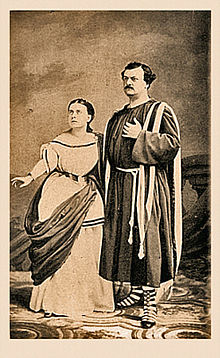
It is said that his singing career began when Marietta Alboni heard him singing at a party and advised him to pursue a professional career. [1] Success in the concert-room encouraged him to appear in opera in Paris and London. [2] His operatic debut was in Paris in Rossini's Mosè in Egitto but he needed training and so he entered the Paris Conservatoire. [1] After a period of study, he appeared in L'elisir d'amore in the role of Nemorino at the Theatre des Italiens. He is also recorded as having sung at the Paris Opera in 1854. [1]
On the invitation of Ole Bull, [1] he came to the United States with Maurice Strakosch in 1855, and soon attained a popularity that lasted almost to the end of his life. His American debut was as Edgardo in Lucia di Lammermoor (12 March 1855) [5] and soon thereafter he sang Manrico in the first American production of Il Trovatore (2 May 1855). [1] [5] Other premiere American performances in which he appeared were La Traviata (1856), I vespri siciliani (1859) and Un ballo in maschera (1861), conducted by Brignoli's friend, Emanuele Muzio at the New York Academy of Music, [6] as well as Luigi Arditi's La Spia (1855) [7] and Betly (1861) at the Philadelphia Academy of Music. [1] Brignoli's first appearance in Boston was on May 25, 1855, as Gennaro in Lucrezia Borgia . [5]
His voice, on his best days, was a tenor of great volume and sweetness, and even in his sixtieth year he was still heard with delight in concert and English opera. He was unrivalled in grace of execution and facility in phrasing. However, he was severely criticized by some for his lack of dramatic skill. [1] [5] He supported Adelina Patti on her 1859 adult debut in the United States, and afterwards sang with Anna de la Grange, Parepa, Nilsson, Tietjens and many other celebrated artists. Brignoli made three trips to Europe but the United States became his adopted home.
In the 1870s, Brignoli, married soprano Sallie Isabella McCullough, and organized an opera company of his own which toured with great success and in which his wife made her operatic debut to a warm reception. Brignoli decided to take his talents back to Europe but the tour was not a success. His voice had begun to crack and he could no longer demand the large salaries that he had been used to receiving. He started to neglect his wife financially and emotionally and she returned to New York and filed for divorce. Brignoli returned for the hearing in which his wife prevailed. Shortly thereafter, Brignoli sailed for Liverpool, under engagement with Colonel Mapleson to sing at Her Majesty's Opera House in London and in other English cities. [8]
Besides the reputed opera of his youth, Brignoli composed other works. One of his orchestral pieces, The Sailor's Dream, was played in Boston in 1868. [5] He also composed songs and a piece titled The Crossing of the Danube which had live cannon in the style of Tchaikovsky's 1812 Overture. [1]
Notwithstanding the large sums of money that he made by his singing, he died in poverty. [2] Nevertheless, his many professional friends and colleagues flocked to his funeral in St. Agnes' Catholic church which was filled to capacity. A funeral march was specially composed for the occasion and played by the entire Seventh Regiment Band at Everett House, where the tenor died. The coffin was surrounded with white roses and other flowers, white doves, a broken column and a crucifix. The pall-bearers included Max Maretzek and several male opera singers. [9] He was survived by a brother and sister who were living in Paris. [10] Since that time, he has been largely forgotten, not even earning a listing in the Grove Dictionary of Music and Musicians or Oxford Music Online. [1] [11]

Brignoli became immensely popular and women besieged him with amorous letters and propositions. [1]
It was not infrequent at this time in the history of American opera for English-language songs to be inserted into operas. In 1879, The New York Times, remarked on the unintended humour in a performance of Don Pasquale , in which Brignoli was appearing at Wallack's Theatre, and into which he had interpolated what had become his theme song, Good-bye, Sweetheart, Good-bye. Brignoli was in the process of being divorced by his wife of nine years, Sallie McCullough, a soprano, whom he had met in 1869. She was from South Carolina and reported to have been very beautiful. [8] The couple had eloped to Montreal and been married in a Presbyterian church without the knowledge of any of their friends. McCullough was from a respected Southern family and the couple were popular with New York society. At this time in his career, he was able to demand and obtain a large salary. In spite of this, Sallie was wretched at home. She described him as 'invariably cross' and that when business was dull, he vent his spite upon her. [8]
When Brignoli went on his European tour in the 1870s, his wife accompanied him. The failure of the venture made him angry and abusive and their relationship intolerable. She also learned that he was being unfaithful. She returned to New York and filed for divorce. The charges made against Brignoli were "habitual cruelty, a neglect to provide for his wife, and adultery." The charge of adultery was proven to the satisfaction of the Referee and the judge issued a decree of absolute divorce. Brignoli sailed back to Europe the same day to complete his engagements in England. [8]
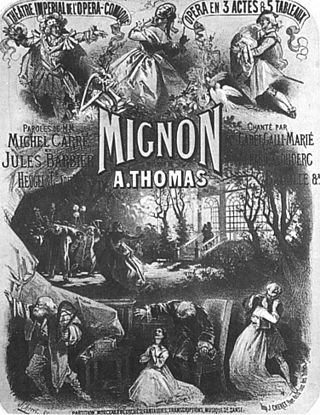
Mignon is an 1866 opéra comique in three acts by Ambroise Thomas. The original French libretto was by Jules Barbier and Michel Carré, based on Goethe's 1795-96 novel Wilhelm Meisters Lehrjahre. The Italian version was translated by Giuseppe Zaffira. The opera is mentioned in James Joyce's "The Dead" and Willa Cather's The Professor's House. Thomas's goddaughter Mignon Nevada was named after the main character.

Sir Charles Santley was an English opera and oratorio singer with a bravura technique who became the most eminent English baritone and male concert singer of the Victorian era. His has been called 'the longest, most distinguished and most versatile vocal career which history records.'

Joseph O'Mara was an Irish opera singer of the Victorian and Edwardian eras. After studying opera in Milan, Italy, he made his London stage debut in 1891 in the tenor title role of the opera Ivanhoe by Arthur Sullivan and soon appeared in other operas. In 1894 he first appeared at Covent Garden Theatre. For three years, he was the principal tenor at Theatre Royal, Drury Lane, also appearing in the pantomime there and elsewhere. In 1896, he created the tenor lead, Mike Murphy, in Charles Villiers Stanford's opera Shamus O'Brien, also playing the role on tour and in America.

Allan James Foley, distinguished 19th century Irish bass opera singer, was born at Cahir, County Tipperary. In accordance with the prevailing preference for Italian artists, he changed the spelling of his name and was always known as 'Signor Foli.'

Thérèse Carolina Johanne Alexandra Tietjens was a leading opera and oratorio soprano. She made her career chiefly in London during the 1860s and 1870s, but her sequence of musical triumphs in the British capital was terminated by cancer.
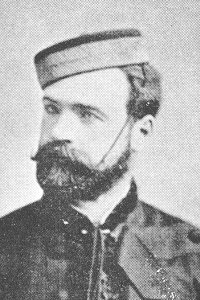
Hugh Talbot, born Hugo Talbot Brennan, was an Irish tenor best known for creating, to universally bad reviews, the role of Frederic in the Gilbert and Sullivan hit The Pirates of Penzance in the original New York production.

Antonio Pini-Corsi was a Dalmatian Italian operatic baritone of international renown. He possessed a ripe-toned voice of great flexibility and displayed tremendous skill at patter singing. Pini-Corsi participated in numerous operatic premieres, portraying on stage such characters as Ford in Giuseppe Verdi's Falstaff and Schaunard in Giacomo Puccini's La bohème. Part of the first generation of recorded musicians, Pini-Corsi was one of the finest buffo singers of his era.

Orville Harrold was an American operatic tenor and musical theatre actor. He began his career in 1906 as a performer in operettas in New York City, and was also seen during his early career in cabaret, musical theatre, and vaudeville performances. With the aid of Oscar Hammerstein I, he branched out into opera in 1910 as a leading tenor with Hammerstein's opera houses in New York City and Philadelphia. While his career from this point on primarily consisted of opera performances, he periodically returned to operetta and musical theatre throughout his career. He notably created the role of Captain Dick Warrington in the world premiere of Victor Herbert's operetta Naughty Marietta in November 1910.
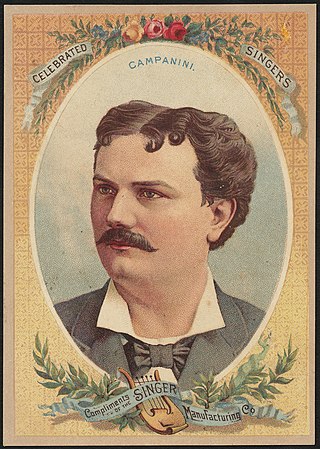
Italo Campanini was a leading Italian operatic tenor, whose career reached its height in London in the 1870s and in New York City in the 1880s and 1890s. He had a repertoire of 80 operas and was the brother of the orchestral conductor Cleofonte Campanini.

Antonio Giuglini was an Italian operatic tenor. During the last eight years of his life, before he developed signs of mental instability, he earned renown as one of the leading stars of the operatic scene in London. He created several major roles for British audiences, appearing in the first London performances of Gounod's Faust and Verdi's Un ballo in maschera. In London, he was the usual stage partner of the great dramatic soprano Thérèse Tietjens.
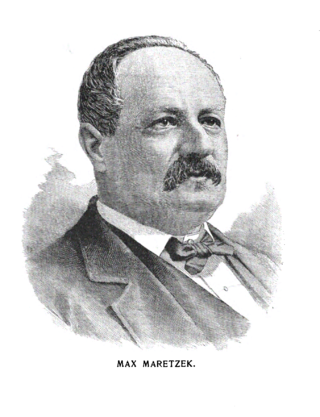
Max Maretzek was a Moravian-born composer, conductor, and impresario active in the United States and Latin America.

Italo Gardoni was a leading operatic tenore di grazia singer from Italy who enjoyed a major international career during the middle decades of the 19th century. Along with Giovanni Mario, Gaetano Fraschini, Enrico Tamberlik and Antonio Giuglini, he was one of the most celebrated Italian tenors of his era.

Karl Johann Franz Formes, also called Charles John Formes, was a German bass opera and oratorio singer who had a long international career especially in Germany, London and New York. At one time extremely famous and in the forefront of his profession, several roles were composed for his voice, most notably that of Plunkett in Flotow's opera Martha.

Marietta Piccolomini was an Italian soprano. She was most famous for the role of Violetta in La Traviata by Giuseppe Verdi, which she performed in England, France, and the United States, as well as her native Italy. After her marriage in 1863, she retired from performing, making only rare charity or courtesy appearances thereafter.

Manuel del Pópulo Vicente Rodriguez García was a Spanish opera singer, composer, impresario, and singing teacher. He is often credited as a key figure in the development of modern vocal technique and vocal pedagogy.

Jean-Vital Jammes was a French opera singer. During a stage career spanning 40 years, he created many leading baritone roles, including Zurga in Bizet's Les pêcheurs de perles and Ourrias in Gounod's Mireille. Born in Le Passage d'Agen near the town of Agen, he was largely self-taught and made his stage debut in 1841 at the age of 16. After singing in several provincial theatres, he was engaged by the Théâtre Lyrique in Paris and later by the Opéra-Comique. Following his retirement from the stage, Ismaël lived in Marseille where he died at the age of 68.

Fernando Carpi was an Italian operatic tenor and later professor of singing.

Adelina Murio-Celli d'Elpeux was a Polish opera singer, music teacher and composer.

George Bentham was an English tenor best remembered today for creating the role of Alexis in the Gilbert and Sullivan comic opera The Sorcerer in 1877. As Giorgio Bentami he pursued a professional opera and concert career in Europe and Britain from 1868 to 1877. Alexis proved to be his last role.

Henri Tayau was an operetta singer and actor, and violinist, who during a short but successful career performed many light tenor roles in opéra-bouffes of Offenbach, and created several roles, the most notable being that of Orphée in Offenbach's greatest success, Orphée aux Enfers.